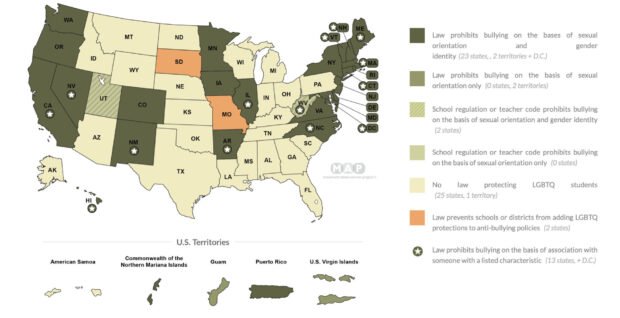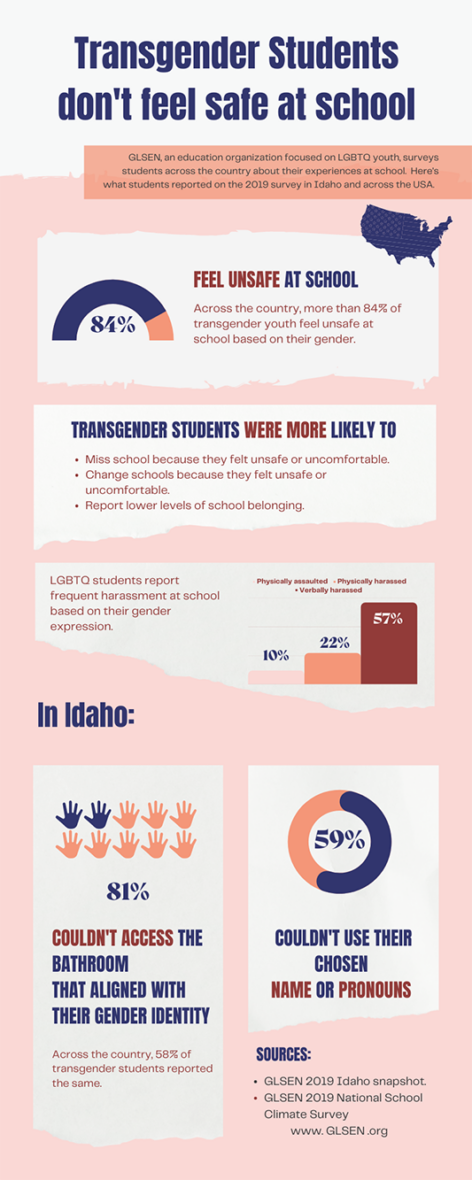This story is the second in a four-story series on Idaho’s failure to comply with the federal Title IX law, and why it matters and how children are affected. The other stories illustrate a call for more training on sexual misconduct, how districts are helping each other improve, and one student’s experience, which has led to a federal investigation.
Editor’s note: Idaho Education News decided to withhold Marley’s last name for her own safety.
Marley B. is counting how many performances she has left with the Jerome High School band.
Playing the flute alongside her friends has been a bright spot in Marley’s otherwise challenging career at the 1,200-student school in central Idaho. She plans to cut ties with Jerome High in May, to join a Job Corps program at the College of Southern Idaho.
Marley’s leaving, she says, because of the emotional toll of a series of disputes with the district, starting with her right to use the women’s restrooms and locker rooms, which school administrators told her she could not use as a transgender female.
“I was just so tired of the fight,” said Marley, 16, who has already switched to homeschool, but still attends elective classes at Jerome High. “I wanted to get away from it all.”
For two years, Marley’s access to the restroom at school has been stymied by confusion among Idaho educators about how Title IX, a federal law that prohibits discrimination based on sex, applies to transgender students and restroom access.
The White House has flip-flopped on whether Title IX protects students from discrimination based on gender identity, and how far that protection extends. In the meantime, Idaho marched forward with state laws to limit transgender students’ rights.
As politicians fought over the issue, a Jerome High School counselor told Marley she couldn’t use the girls’ restrooms, because the question of bathroom access was “unresolved” in Idaho.
Marley filed a federal complaint against Jerome in 2020, alleging the school was violating her Title IX rights. The Department of Education’s Office for Civil Rights officially opened an investigation into Marley’s complaint in December 2021.
Amid the investigation, questions from the press, and changing federal guidance around Title IX protections for transgender youth, Jerome Superintendent Pat Charlton told Marley in February that she can now use the women’s restroom. Charlton says that right has been extended to transgender students on an individual basis since last fall.
“I look at it like a victory in a sense,” said Sara B., Marley’s mother. “But it took this much to get it done, and it shouldn’t be that difficult.”
The federal government seesaws over transgender student protections
Federal guidelines for interpreting how Title IX applies to transgender youth have changed repeatedly in the past few years.
The U.S. Department of Education under Barack Obama said schools “must not treat a transgender student differently from the way it treats other students of the same gender identity.” Obama specifically directed schools to allow transgender students to access the restrooms and locker rooms that align with their gender identities.
Those rules were rescinded less than a year later, when Donald Trump became president. The Trump administration argued that Obama’s guidance had raised various legal questions and said it wouldn’t enforce Title IX protections around gender identity.
Fast forward to 2021. Last year, President Joe Biden’s administration again said schools will be considered in violation of Title IX if they are found to be discriminating against students based on their sexual orientation or gender identity — a swing back to Obama era policies.
Idaho is pushing back. State Attorney General Lawrence Wasden joined 20 republican Attorneys General who sent a letter to the White House this summer, arguing that the Department of Education is trying to rewrite Title IX without going through the proper procedures. They also argued that Biden’s direction on how to apply Title IX to transgender students was too vague.
“Schools are left to wonder whether… your administration will seek to punish them if they exclude boys who identify as girls from the girls’ showers and locker rooms after gym class,” the letter says.

Idaho is a leader in the fight to restrict transgender rights in athletics
At least 18 states have adopted school regulations that explicitly grant transgender youth access to restrooms, locker rooms and sports teams that match their gender identity, according to the Movement Advancement Project, which maps LGBT protections by state.
Idaho has moved in the opposite direction. In 2020, the state became the first to ban transgender women and girls from competing in women’s school athletics.
That law is being disputed in the courts, and both sides have tried to leverage Title IX.
Proponents of the so-called “Fairness in Women’s Sports Act” argue that transgender women have an advantage in sports because they were assigned male at birth. Allowing transgender girls to participate in sports, they say, undermines women’s access to athletics, which was one of the original protections won by Title IX.
LGBT activists argue that the state law violates Title IX by expressly denying transgender girls and women the opportunity to play on sports teams on the basis of sex.
Implementation of the 2020 law is currently on hold as it winds its way through court. Several states have followed Idaho in banning transgender girls from women’s sports.
“Idaho is very concerning with how it’s treating trans folks, trans students, nonbinary folks. It appears to kind of show us where the rest of the country might go,” said Catherine West, a staff attorney for Legal Voice, which is fighting the transgender sports bill in court alongside the ACLU.
“You just want to feel safe”
Idaho doesn’t have rules that specifically govern restroom access. The State Department of Education says it “does not have authority” over what bathroom accommodations districts and charters provide for their students.
Marley says Jerome’s refusal to let her use the women’s restroom was a relentless stressor during her freshman year. It contributed to frequent panic attacks, she said, where she would sit in the hallway shaking, unable to make it to class as she wrestled “constant what-if’s.”
What if she got COVID-19 at school, and took it home to her medically-vulnerable father? What if her teachers used the wrong pronoun, or the boy’s name listed on her school documents, and her classmates started to use that name, too? What if something happened to her in the bathroom again?
In the spring of her eighth-grade year, not long after she came out as transgender, Marley was attacked by a stranger in a men’s restroom. The trauma of the experience added another layer of terror to Marley’s struggle to find a bathroom where she feels comfortable.
“You just want to feel safe. I think people take that for granted,” Sara said. “Going to the restroom is just a secondary thing, most people don’t think about it. But when you feel vulnerable, it’s important to be able to go somewhere you feel comfortable.”
Administrators at Jerome High School told Marley she could use the gender-neutral bathrooms on campus. But two months into the 2020-21 school year, Marley told them that she was struggling to access those. One bathroom was so far out of her way she risked being tardy if she had to use it between classes. Another had a broken lock that made her feel unsafe.
Marley asked if she could use the girl’s restroom, which felt like a safe space. The answer was no. Administrators wrote into Marley’s education file that she could leave during class, or before the bell to go to the restroom. But the girl’s restroom was off-limits.
Marley filed a complaint with the federal government, then wrote a letter to her school’s news website, alleging Jerome was breaking the law.
“It should be a simple right and not have to be a fight to use these restrooms,” Marley wrote.
Federal courts have ruled that transgender students should be able to access the restrooms that align with their gender identity.
A U.S. appeals court has twice upheld a ruling in the case of Gavin Grimm, a transgender student who sued a Virginia school district in 2015 for denying him access to the men’s restroom, finding the policy was unconstitutional under Title IX, and the 14th amendment’s Equal Protection Clause. The U.S. supreme court declined to hear that case, so there is no national ruling on the topic.
Jerome’s attorney says that bathroom access remains “a matter of unsettled law” in Idaho.
In response to the Office for Civil Rights investigation, attorney James Stoll argued that no court with jurisdiction over Idaho has made a ruling on a bathroom case. Interpretations of what constitutes sex-based discrimination has been “evolving in the courts,” Stoll wrote, and the Trump administration added to districts’ confusion when it repealed Obama’s bathroom rules.
At the time of Marley’s complaint, Stoll wrote: “It was reasonable for the District to follow the Department of Education’s guidance when it denied (Marley’s) request to use the bathroom and locker rooms corresponding with her gender identity.”
Ritchie Eppink, a lawyer for the ACLU, argues there’s been a “failure of leadership” in Idaho around transgender students’ rights.
“School districts were left to their own devices in figuring out what they wanted to do here,” Eppink said. “The safety and the health of school climates is treated like a political issue by leaders in the state.”
Policies changing at Jerome under new leadership
By the time the Office for Civil Rights officially opened Marley’s complaint for investigation, she was no longer enrolled at Jerome High.
Marley opted for homeschool this year, after anxiety and health issues caused her to miss so much school she lost class credits. She still takes some electives at the high school, which is allowed under Idaho’s homeschool rules.
The district and federal government are now under new leadership as well. After assuming office in 2021, Biden told schools they were expected to apply Title IX to students based on their gender identity. Charlton, who is in his first year at Jerome, says this was already written into the district’s policies.
“I can’t speculate as to why there was not strict adherence to policy other than the confusion presented by the previous presidential administration putting a hold on the rights of transgender students,” Charlton told EdNews.
Starting last fall, Charlton says, Jerome’s secondary schools started using “care teams” designed to help students that are struggling for whatever reason. For transgender youth, those care teams are creating Gender Support Plans, which can include allowing students to access the restrooms that match their gender identity. A district committee is also working on revising Jerome’s gender inclusion policies, Charlton said.
On the last Friday in February, Charlton called Marley to the principal’s office while she was on campus for an elective class. He told her she could use the women’s restroom.
Marley says the new rules probably won’t change her decision to leave for CSI. Changing policies are a benefit for the next generation, Sara says, including one of Marley’s younger siblings, who is nonbinary.
“It’s a small town, but we know a lot of the kids here, and it’s becoming more and more prevalent – kids are coming out, and they’re needing these accommodations,” Sara said.
